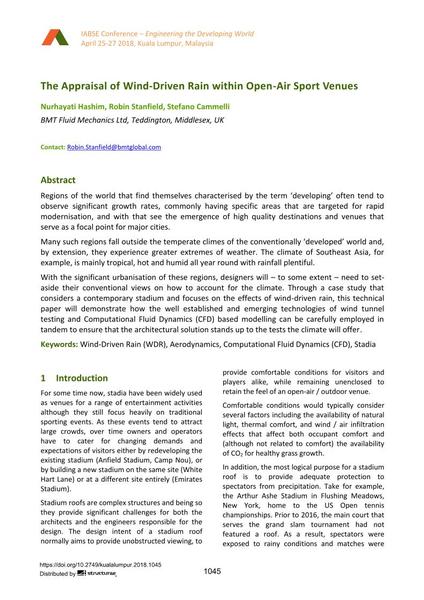The Appraisal of Wind-Driven Rain within Open-Air Sport Venues

|
|
|||||||||||
Détails bibliographiques
| Auteur(s): |
Robin Alan Stanfield
(BMT Fluid Mechanics Ltd, Teddington, Middlesex, UK)
Stefano Cammelli (BMT Fluid Mechanics Ltd, Teddington, Middlesex, UK) Hayati Hashim (BMT Fluid Mechanics Ltd, Teddington, Middlesex, UK) |
||||
|---|---|---|---|---|---|
| Médium: | papier de conférence | ||||
| Langue(s): | anglais | ||||
| Conférence: | IABSE Conference: Engineering the Developing World, Kuala Lumpur, Malaysia, 25-27 April 2018 | ||||
| Publié dans: | IABSE Conference Kuala Lumpur 2018 | ||||
|
|||||
| Page(s): | 1045-1051 | ||||
| Nombre total de pages (du PDF): | 7 | ||||
| DOI: | 10.2749/kualalumpur.2018.1045 | ||||
| Abstrait: |
Regions of the world that find themselves characterised by the term ‘developing’ often tend to observe significant growth rates, commonly having specific areas that are targeted for rapid modernisation, and with that see the emergence of high quality destinations and venues that serve as a focal point for major cities. Many such regions fall outside the temperate climes of the conventionally ‘developed’ world and, by extension, they experience greater extremes of weather. The climate of Southeast Asia, for example, is mainly tropical, hot and humid all year round with rainfall plentiful. With the significant urbanisation of these regions, designers will – to some extent – need to set- aside their conventional views on how to account for the climate. Through a case study that considers a contemporary stadium and focuses on the effects of wind-driven rain, this technical paper will demonstrate how the well established and emerging technologies of wind tunnel testing and Computational Fluid Dynamics (CFD) based modelling can be carefully employed in tandem to ensure that the architectural solution stands up to the tests the climate will offer. |
||||
| Mots-clé: |
stades
|
||||
